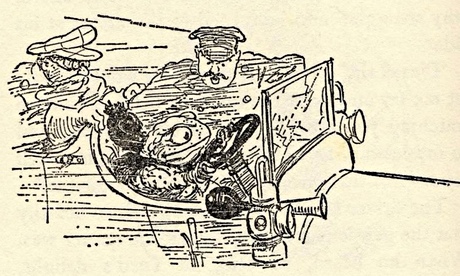
The Wind in the Willows, known to many readers through theatrical adaptations such as Toad of Toad Hall, belongs to a select group of English classics whose characters (Rat, Mole, Badger and Mr Toad) and their catchphrases ("messing about in boats"; "poop, poop!") require no introduction. Endlessly recycled, in print, cartoon and cinema, the ideas and images of Kenneth Grahame's masterpiece recur in the most unlikely places. Chapter seven, "The Piper at the Gates of Dawn", is also the name of Pink Floyd's first album in 1967.
A sentimental British favourite, The Wind in the Willows is a far more interesting book than its popular and often juvenile audience might suggest. First, it is the work of a writer who had known considerable success in the 1890s as a young contemporary of Oscar Wilde, and who was also an admired contributor to the literary quarterly The Yellow Book. At that point, Grahame was employed by the Bank of England but, still in his 20s, was publishing stories in literary magazines, work that became collected in Dream Days (1895) and an even more successful publication, The Golden Age (1898).
The text of The Wind in the Willows also encrypts a family tragedy. In 1899, Grahame married and had one child, a boy named Alastair who was troubled with health problems and a difficult personality, culminating in the boy's eventual suicide, the cause of much parental anguish. When Grahame finally retired from the Bank (as secretary) in 1908, he could concentrate on the stories he had been telling his son, the stories of the Thames riverbank on which Grahame himself had grown up. So The Wind in the Willows is a tale steeped in nostalgia, and inspired by a father's obsessive love for his only son.
Within the text, the reader discovers two tales, interwoven. There are, famously, the adventures of Mole, Ratty, Badger and Toad with the canary-coloured caravan, the succession of motor cars, and the climactic battle for Toad Hall. At the same time, there are Grahame's lyrical explorations of home life ("Dulce Domum"), river life ("Wayfarers All") and childhood itself ("The Piper at the Gates of Dawn"). In most theatrical adaptations of Grahame's book, these lyrical elements are ruthlessly subordinated to the demands of the plot.
Above all, The Wind in the Willows makes a powerful contribution to the mythology of Edwardian England not only through its evocation of the turning seasons of the English countryside, from the riverbank in summer to the rolling open road, but also through its hints of an imminent class struggle from the inhabitants (stoats and weasels) of the Wild Wood.
Like the other books for children selected for this series – notably Alice's Adventures in Wonderland (no 18) and Kim (no 34) – The Wind in the Willows deserves recognition as a novel in which adult readers will find wisdom, humour, entertainment and meaning, as well as many passages of great literary power, together with characters who live on in the English literary unconscious.
A note on the text
The Wind in the Willows began as bedtime stories and letters addressed to Grahame's troubled son, a sickly boy known as "Mouse" who possibly inspired the wilful character of Mr Toad and who eventually committed suicide, aged 20, while at Oxford. Indeed, so personal were these stories that Grahame never intended to publish his material. The manuscript was first given to an American publisher, who rejected it. After the publication of The Wind in the Willows by Methuen in 1908, it found an unlikely transatlantic fan in US president Theodore Roosevelt who, in 1909, wrote to Grahame to tell him that he had "read it and reread it, and have come to accept the characters as old friends". Elsewhere, the critical response was more mixed, and it was not until AA Milne adapted parts of the book into a popular stage version, Toad of Toad Hall, in 1929, that it became established as the evergreen children's classic it is known as today.
Three more from Kenneth Grahame
Pagan Papers (1893); The Golden Age (1895); Dream Days (1898), a volume that includes another children's story, The Reluctant Dragon.

